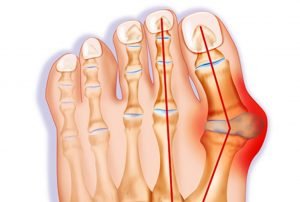Lapidus Arthrodesis to treat bunion deformity
 If the joint that connects your big toe to your foot has a swollen, sore bump, you may have a bunion. Do not confuse with Hammer Toe. With a bunion, the base of your big toe (metatarsophalangeal joint) gets larger and sticks out. The skin over it may be red and tender. Wearing any type of shoe may be painful. This joint flexes with every step you take. The bigger your bunion gets, the more it hurts to walk. Bursitis may set in. Your big toe may angle toward your second toe, or even move all the way under it. The skin on the bottom of your foot may become thicker and painful. Pressure from your big toe may force your second toe out of alignment, sometimes overlapping your third toe. An advanced bunion may make your foot look grotesque. If your bunion gets too severe, it may be difficult to walk. Your pain may become chronic, and you may develop arthritis. Very severe bunions require surgery to treat. A surgeon may correct the deformity with a few options including a procedure called Lapidus arthrodesis.
If the joint that connects your big toe to your foot has a swollen, sore bump, you may have a bunion. Do not confuse with Hammer Toe. With a bunion, the base of your big toe (metatarsophalangeal joint) gets larger and sticks out. The skin over it may be red and tender. Wearing any type of shoe may be painful. This joint flexes with every step you take. The bigger your bunion gets, the more it hurts to walk. Bursitis may set in. Your big toe may angle toward your second toe, or even move all the way under it. The skin on the bottom of your foot may become thicker and painful. Pressure from your big toe may force your second toe out of alignment, sometimes overlapping your third toe. An advanced bunion may make your foot look grotesque. If your bunion gets too severe, it may be difficult to walk. Your pain may become chronic, and you may develop arthritis. Very severe bunions require surgery to treat. A surgeon may correct the deformity with a few options including a procedure called Lapidus arthrodesis.
The Lapidus arthrodesis Procedure
The surgeon begins by making an incision on the top side of the foot above the first metatarsal and tarsal joint exposing the joint. After attaching a joint distractor to both sides of the joint the surgeon distracts the joint fully exposing the interior of the joint. The surgeon prepares the fusion site by removing the remaining cartilage and tips of the bones with a bone saw, and then drills a series of holes on fusion surfaces to ensure a strong bond. The surgeon then uses the joint distractor to compress the surfaces together and temporarily fixates them with guide wires drilled through the joint. The surgeon then temporarily attaches a compression plate over the dorsal medial aspect of the joint and begins to install permanent screws into the tarsal. After securing the tarsal side of the plate the surgeon removes the guide wires and drills an acentric hole on the metatarsal side that compress the joint during screw placement. After placing all the screws into the compression plate the surgeon further compresses the joint by bending a metal compression mechanism in the place with a specialized tool. Fusion of the joint will finalize during the recovery period as bone grows into bone on the prepared surfaces. A Lapidus arthrodesis eliminates the bunion by preventing the angular deformity from manifesting on the next joint.
Lapidus arthrodesis recovery
Recovery from a Lapidus bunion correction surgery involves non-weight bearing for about six weeks before graduating to partial weight bearing with a boot for the next few weeks. Bones heal in roughly 6-8 weeks in healthy individuals. Many patients resume normal activity by 12 weeks. Weight bearing before the joint has fused can result in a non-union of the two bones. Patients that smoke, bear weight, or are diabetic have higher rates of non-union and are subject to additional surgical correction to -achieve proper healing.

